
- Basic Electronics - Materials
- Basic Electronics - Energy Bands
- Basic Electronics - Semiconductors
- Basic Electronics - Hall Effect
- Resistors
- Basic Electronics - Resistors
- Circuit Connections in Resistors
- Non-linear Resistors
- Basic Electronics - Linear Resistors
- Basic Electronics - Fixed Resistors
- Capacitors
- Basic Electronics - Capacitors
- Circuit Connections in Capacitors
- Variable Capacitors
- Basic Electronics - Fixed Capacitors
- Polarized Capacitors
- Inductors
- Basic Electronics - Inductors
- Basic Electronics - Inductance
- Circuit Connections in Inductors
- Types of Inductors
- Basic Electronics - RF Inductors
- Transformers
- Basic Electronics - Transformers
- Types of Transformers
- Transformers based on Usage
- Transformer Efficiency
- Diodes
- Basic Electronics - Diodes
- Basic Electronics - Junction Diodes
- Special Purpose Diodes
- Optoelectronic Diodes
- Transistors
- Basic Electronics - Transistors
- Transistor Configurations
- Transistor Regions of Operation
- Transistor Load Line Analysis
- Types of Transistors
- Basic Electronics - JFET
- Basic Electronics - MOSFET
- Basic Electronics Useful Resources
- Basic Electronics - Quick Guide
- Basic Electronics - Useful Resources
- Basic Electronics - Discussion
Basic Electronics - Polarized Capacitors
Polarized Capacitors are the ones that have specific positive and negative polarities. While using these capacitors in circuits, it should always be taken care that they are connected in perfect polarities. The following image shows the classification of polarized capacitors.
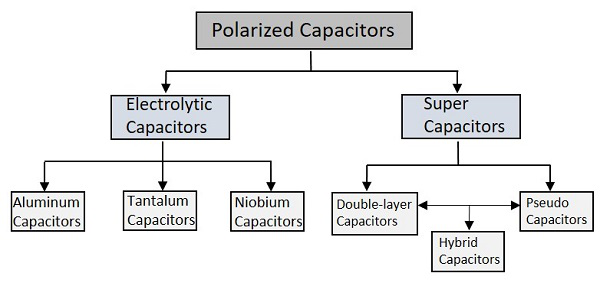
Lets start the discussion with Electrolytic Capacitors.
Electrolytic Capacitors
The Electrolytic Capacitors are the capacitors which indicate by the name that some electrolyte is used in it. They are polarized capacitors which have anode (+) and cathode (-) with particular polarities.
A metal on which insulating oxide layer forms by anodizing is called as an Anode. A solid or non-solid electrolyte which covers the surface of the oxide layer, functions as a cathode. The Electrolytic Capacitors have much higher Capacitance-Voltage (CV) value than the others, due to their larger anode surface and thin dielectric oxide layer.
Aluminum Electrolytic Capacitors
Aluminum Electrolytic Capacitors are the most common types among the Electrolytic capacitors. In these ones, a pure Aluminum foil with an etched surface acts as an Anode. A thin layer of metal, which has a thickness of few micrometers acts as a diffusion barrier, which is placed between two metals to separate electrically. Hence the diffusion barrier acts as a dielectric. The electrolyte acts as a cathode which covers the rough surface of oxide layer.
The following figure shows an image of different sizes of Aluminum Electrolytic Capacitors available.
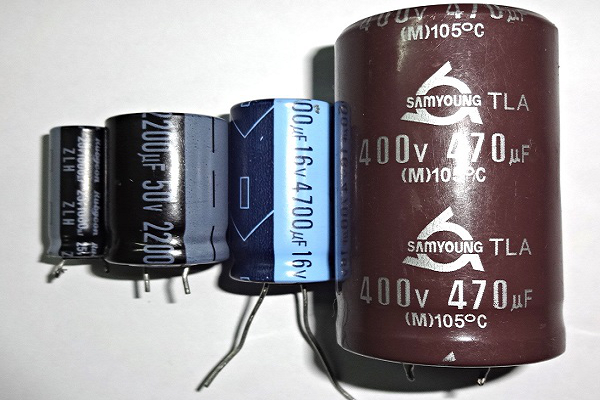
Depending upon the electrolyte there are three types of Aluminum Electrolytic Capacitors. They are −
- Wet Aluminum Electrolytic capacitors (non-solid)
- Manganese dioxide Aluminum Electrolytic capacitors (solid)
- Polymer Aluminum Electrolytic capacitors (solid)
The main advantage with these Aluminum Electrolytic capacitors is that, they have low impedance values even at mains frequency and they are cheaper. These are mostly used in Power supply circuits, SMPS (Switched Mode Power Supply) and DC-DC Converters.
Tantalum Electrolytic capacitors
These are another type of Electrolytic capacitors whose anode is made up of tantalum on which a very thin insulating oxide layer is formed. This layer acts as a dielectric and the electrolyte acts as a cathode which covers the surface of oxide layer.
The following figure shows how tantalum capacitors look like.
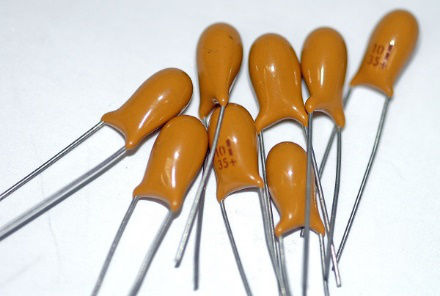
Tantalum provides high permittivity dielectric layer. Tantalum has high capacitance per volume and lower weight. But these ones are costlier than Aluminum Electrolytic capacitors, due to the frequent unavailability of tantalum.
Niobium Electrolytic Capacitors
A Niobium Electrolytic Capacitor is the other type of Electrolytic Capacitors in which a passivated niobium metal or niobium monoxide is considered as anode and an insulating niobium pentoxide layer is added on to the anode, so that it acts as a dielectric. A solid electrolyte is laid on the surface of the oxide layer which acts as a cathode. The following figure shows how Niobium capacitors look like.
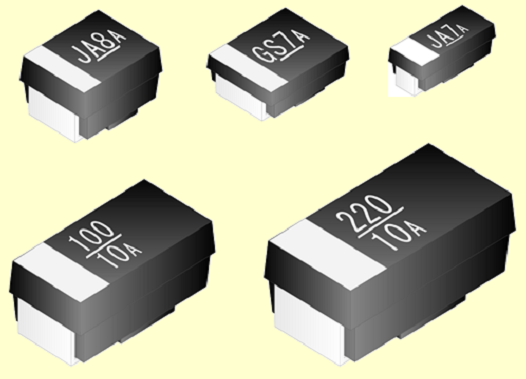
The Niobium Capacitors are commonly available as SMD (Surface Mount Devices) chip capacitors. These are easily fitted in a PCB. These capacitors should be operated in perfect polarities. Any kind of reverse voltage or ripple current higher than the specified will eventually destroy the dielectric and the capacitor as well.
Super Capacitors
The high capacity electrochemical capacitors with capacitance values much higher than the other capacitors, are called as Super Capacitors. These can be categorized as a group that lies between electrolytic capacitors and rechargeable batteries. These are also called as Ultra Capacitors.
There are many advantages with these capacitors such as −
- They have high capacitance value.
- They can store and deliver charge much faster.
- They can handle more charge and discharge cycles.
These capacitors have many applications such as −
- They are used in cars, buses, trains, elevators and cranes.
- They are used in regenerative braking.
- They are used for memory backup.
The types of super capacitors are Double-layered, Pseudo and Hybrid ones.
Double-layered Capacitors
Double-layered capacitors are electrostatic capacitors. The charge deposition is done in these capacitors according to the principle of Double-layer.
All solid substances have negative charge on the surface layer when disposed into a liquid.
This is due to the high dielectric coefficient of liquid.
All the positive ions come near the surface of the solid material to make a skin.
The deposition of positive ions near the solid material get looser with the distance.
The charge created at this surface due to the deposition of anions and cations leads to some capacitance value.
This double-layer phenomenon is also termed as Helmholtz double layer. The figure below explains the procedure of double-layer phenomenon, when the capacitor is charged and when it is discharged.
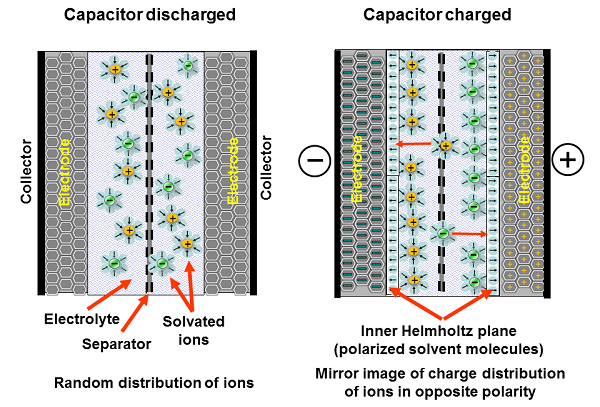
These capacitors are simply called as Electric Double Layered Capacitors (EDLC). They use carbon electrodes to achieve separation of charge between the surface of conductive electrode and the electrolyte. The carbon acts as dielectric and the other two as anode and cathode. The separation of charge is much smaller than in a conventional capacitor.
Pseudo Capacitors
These capacitors follow the electrochemical process for the deposition of charge. This is also called as faradaic process. At an electrode, when some chemical substance reduces or oxidizes, some current is generated. During such process, these capacitors store the electric charge by electron transfer between electrode and electrolyte. This is the working principle of Pseudo capacitors.
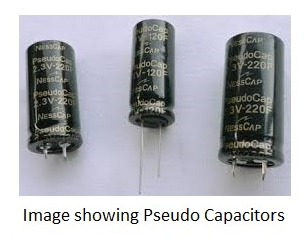
They get charged much faster and store the charge as much as a battery does. They are operated at a faster rate. These are used in tandem with batteries to improve life. These are used in grid applications to handle power fluctuations.
Hybrid Capacitors
A Hybrid Capacitor is a combination of EDLC and Pseudo Capacitor. In the Hybrid capacitors, activated carbon is used as cathode and the pre-doped carbon material acts as anode. Li ion capacitor is the common example of this type. The following figure shows different types of Hybrid Capacitors.
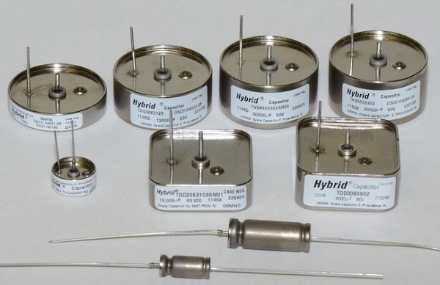
They have high tolerance in a wide range of temperature variations from -55C to 200C. Hybrid capacitors are also used in airborne applications. Though cost is high, these capacitors are highly reliable and compact. These are rugged and can tolerate extreme shock, vibration and pressure from environment. Hybrid capacitors have higher energy density and higher specific power than any electrolytic capacitor.